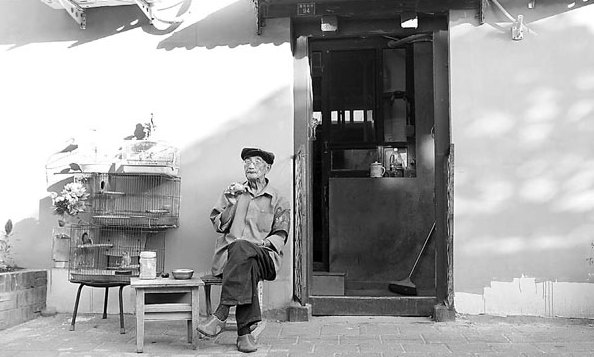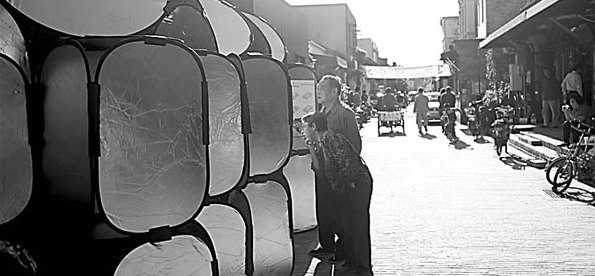Dashila'r set for a makeover
Updated: 2013-09-29 07:27
By Chen Nan(China Daily)
|
|||||||
Beijing Design Week 2013 aims to breathe new life into one of Beijing's oldest hutong areas. Chen Nan reports.
Dashila'r, one of the oldest hutong areas in Beijing, will be charged with creativity during the Beijing Design Week 2013, which began on Sept 26 and will run until Oct 3.
Located south of Tianan'men Square, the area has long been an icon in Beijing, which is home to Chinese time-honored brands, international shops, traditional teahouses, hutong and courtyards. Formed during the Ming Dynasty (1368-1644), the area became the most prosperous and civilized corner of the city.
According to Beatrice Leanza, the new Creative Director of Beijing Design Week, since UNESCO designated Beijing as a City of Design a year ago, the event is hoping to reinforce the capital's role as an active provider of infrastructural and cultural systems.
|
An elderly man sips tea in front of his courtyard gate in the Dashila'r area near several birds in cages. Such birds are popular pets for old Beijingers. Photos by Zou Hong / China Daily |
"Dashila'r has traces of the imperial past, the traditional courtyard houses, and abounds in a richness of stories. We want to follow the revitalization scheme to give the area a new life," she says.
She also hopes that Beijing Design Week will be more "Beijing" than a "design week". "Though it's called 'design week', we want to make it last throughout the whole year," she says.
Like many hutong areas of Beijing, Dashila'r has become a center of debate about new and old values, such as developments and preservation during the past few years.
This year, Beijing Design Week has launched the Dashila'r Pilot project, inviting top international and local designers, architects and academies to create a lab to generate unique ideas, which will be unveiled to the public.
Along with the lab, installations and a pop-up shop will also be set up to generate ideas for preserving Beijing's historical alleyways. A wide program featuring contemporary craft shows, historical exhibitions, and architectural research from local and international studios will also be open to visitors.
Chinese architect Zhang Ke, of Standard Architecture, has spent more than a year in the Dashila'r area. He set his eyes on Yangmeishu Xiejie, a narrow hutong in the Dashila'r area, which has about 40 families living in a 550-square-meter area.
His Micro Hutong project has transformed two courtyards into a complex with residential houses, restaurants, bookstores and bars.
Yangmeishu Xiejie has been an important project in the Qianmen area restoration. Of the more than 1,700 families living there, more than 500 moved out and the local government has been working on the rearrangement and improvement of the area's remaining families and their houses.

"It's an experiment and we didn't make it big," says Zhang. "For many old residential areas in Beijing, the hutong and courtyards are still there but the people who were living in them are not there anymore. Some of them moved out and some rent their houses to other people, like restaurant owners. It's not healthy. We want the residents to live in harmony with other new things, like bookstores and bars."
Zhang realized his idea in his design, which is a transparent house built in a courtyard. But he also says that transforming old courtyards takes at least three years now that each courtyard has different families and situations.
Designer Lin Lin, who is also the co-founder of local creative studio Jellymon, has also participated in restoring courtyards in the area. She moved her studio into one of the courtyards last year, which kicked off her long-term project of keeping the architecture alive and revitalized.
During last year's Beijing Design Week, she took over five rooms in a hutong in the Dashila'r area to present her latest creative projects to the public, including accessories and furniture, a new food endeavor and a sneaker branding concept.
UK designer Michael Young has made a public toilet at Yangmeishu Xiejie. The project means a lot for hutong residents, who don't have private toilets at home.
The interior structure of the toilets is convenient for cleaning and the sewage system is easily managed. The exterior is decorated with tiles, which echoes the surrounding architecture and ensures the indoor temperature remains comfortable in winter.
Jia Rong, associate general manager of Beijing Dashila'r Investment Company, says that since 2008, they have been trying to figure out solutions to improve the area's infrastructure, preserving its history while keeping it alive and progressive.
She also points out the Dashila'r area has a population density six times higher than Beijing's average, which makes it difficult and complicated for developers to improve and renew it.
The company first decided to join forces with Beijing Design Week in 2011. In its first year, more than 20 designers, architects and organizations joined in projects. That year, more than 20,000 tourists came to the Dashila'r area and gave warm feedback to the design works, which gave the company confidence.
"Since then, we decided to do micro-planning to the area, which is not only a way to test people's reactions but also to make adjustments during the restoration," Jia says. "The local communities' opinions are crucial. We will make the good designs and architectural works into a long-term plan for the area."
Contact the writer at chennan@chinadaily.com.cn.
|
Residents are curious about the installation works under preparation for the Beijing Design Week. |
(China Daily 09/29/2013 page15)

